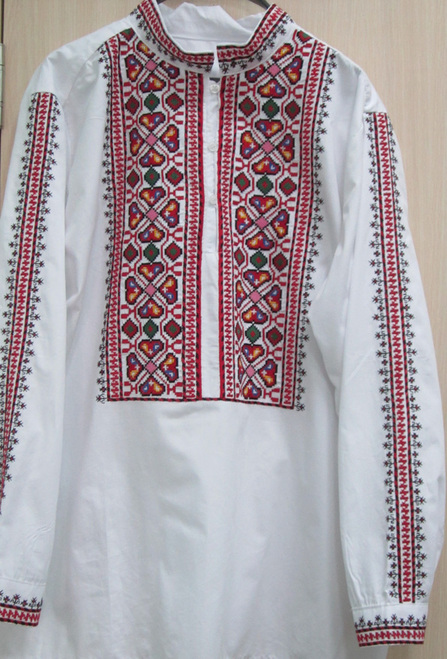From "Once upon a time - manners and worldview of the Bulgarians"
Traditional folk clothing is the most valuable source for revealing the ethnic unity and diversity of traditional Bulgarian culture. It is primarily the work of home production - of women's sense and creativity. The place of men in this process is insignificant: in some cases they take part in processing skins or in sewing them into pieces of clothing. The traditional textile materials for making clothing fabrics are linen, hemp, wool, silk and cotton, which massively entered home weaving in the second half of the 19th century. Leather occupies a relatively limited place - for the hood, trousers, and turbans. It is traditionally present mainly in the composition of the men's costume, common in the high mountain areas. The structure of Bulgarian folk costumes is complex. It changes depending on the specific working conditions and lifestyle in the patriarchal Bulgarian village.
Folklore collection "Once upon a time - manners and worldview of the Bulgarians"
The wool is of animal origin - a symbol of the wild and the base. But it is ennobled by human labor after spinning, knitting, dyeing, and is already a sign of controlled chaos. There is another symbolism in this material. The cosmic order is top – middle – bottom. The elements of this order are linen (the world of the upper, of the holy - wool (the world of the middle, of the earth) - leather (chaos and the lower world).
The way of dressing the ancient Bulgarians is interesting:
- a linen shirt /associated with the most sacred moments of a person's life - baptism, wedding, death/;
– woolen outerwear /the visible appearance/;
- leather waistcoats and fur coats /leather-trimmed ends of clothing with a protective function/.
This can also be connected with the triple composition of man - spirit, soul and body. Perhaps there is a similar message in the triple coffins in which the Egyptian mummies are buried - as the transition from the sacred to the more primitive is precisely from the inside to the outside /gold - wood - stone/.
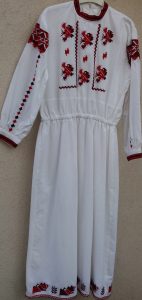 The shirt - the first among clothes. The shirt with embroidery is the first and perhaps the most important garment of a Bulgarian's clothing. It directly touches the skin and is the first layer that protects the human body from external harmful influences, evil forces, etc. The shirt is sacred. From baptism to burial, it is invariably present in a person's clothing. It is made personally by the woman in the family and is a ritual gift - a sign of kinship. The materials from which it is made - linen and hemp - speak of its sanctity. These fabrics were believed to have a protective power, and the impossibility of counting the threads in the sleeve was considered a sure protection against lessons. In her shirt, the Bulgarian woman depicts her ideas about the world by using rich Vesbian ornamentation.
The shirt - the first among clothes. The shirt with embroidery is the first and perhaps the most important garment of a Bulgarian's clothing. It directly touches the skin and is the first layer that protects the human body from external harmful influences, evil forces, etc. The shirt is sacred. From baptism to burial, it is invariably present in a person's clothing. It is made personally by the woman in the family and is a ritual gift - a sign of kinship. The materials from which it is made - linen and hemp - speak of its sanctity. These fabrics were believed to have a protective power, and the impossibility of counting the threads in the sleeve was considered a sure protection against lessons. In her shirt, the Bulgarian woman depicts her ideas about the world by using rich Vesbian ornamentation.
The construction of this garment has no branches, but resembles a cross, following the cruciformity of the man with outstretched arms. Three colors predominate: white, red and black. White and red represent the masculine and feminine, and their intertwining - the Bulgarian martenitsa - symbolizes living life. They are in opposition to black - a symbol of the loss of the body. The child receives his first shirt at his baptism. While the form is the same for all, the decoration is rich and varied and carries certain information. After baptism, every important event in a person's life is marked with a new shirt - the first tooth, the first step, the period of sexual maturity, a wedding. The girl only makes the decoration of her shirt and her clothes in general. When exporting, a strictly defined model of the settlement or region is followed and no deviations are allowed. This specimen is kept on a piece of cloth by the most knowledgeable woman in the village. The skills and abilities of the girl in embroidery are the main and "weapons" for competition in the marriage market. Marriage is the pinnacle event in the life of a Bulgarian. That is why the wedding shirt has very rich ornaments and a better quality fabric.
See also: Importance of Types of Garment Parts – Part 2
This shirt is carefully preserved until old age as a garment for heaven. It was believed that in heaven, the man and the woman will recognize each other by the shirt and they will get together. For a woman, the shirt is the thing that shapes her identity and her only and personal property. In the Bulgarian tradition, the woman had no right to inheritance, she and the children belonged to the man's family. For a man, shirts are a gift created by the women who belong to the male line - mother, wife, sisters-in-law. The embroidery in the men's clothing is a mark to distinguish the status of the man in the society. The rich ornamentation is a symbol of transition into a period of sexual maturity and the readiness of the boy to become a man. Young men and women are allowed to wear richly decorated shirts. Adult men and women are deprived of the red color and the presence of embroidery. The absence of these elements indicates that they no longer participate in the process of reproduction of the genus.
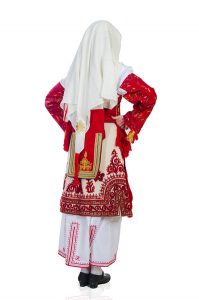 Outerwear – gender-separated clothing. While the shirt is cut the same for both sexes, the outer garment is quite different. While the shirt is white, the rest of the Bulgarians' clothing is contrasting in color. The woman prepares the main part of the clothes that she will wear during her unmarried life.
Outerwear – gender-separated clothing. While the shirt is cut the same for both sexes, the outer garment is quite different. While the shirt is white, the rest of the Bulgarians' clothing is contrasting in color. The woman prepares the main part of the clothes that she will wear during her unmarried life.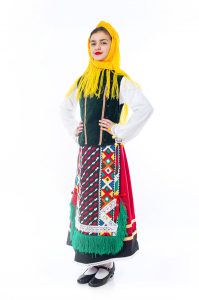
The type of upper garment gives accurate information about the position of the woman - unmarried but ready for marriage, young bride, bride (established, gave birth to one or two children), old woman. By tucking the skirts back into the belt, the woman's most active period is marked. It is used for aprons, cloth and sayan costumes. The skirts are decorated from below.
Puberty women wear mostly red cloths with rich decoration, and adults - mostly black or dark ones with poor or no ornamentation. The right to wear trousers comes at a certain age - 7-8 years, and in some regions this is accompanied by a custom. This is the age at which the boy becomes involved in the work of the family, which is divided by gender. 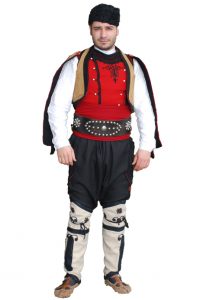 From that moment, the child leaves the circle of the mother, the grandmother and begins to acquire typical male skills and knowledge related to the activity with which he will support himself and his future family. Until he has mastered all the skills and knowledge, no one is considered ready for marriage and is not allowed to use the signs in the clothing of adults. The grown-up youth who is ready for marriage wears clothing richly decorated with cords and stripes. Growths are added at the end of the leg, "like not a rooster".
From that moment, the child leaves the circle of the mother, the grandmother and begins to acquire typical male skills and knowledge related to the activity with which he will support himself and his future family. Until he has mastered all the skills and knowledge, no one is considered ready for marriage and is not allowed to use the signs in the clothing of adults. The grown-up youth who is ready for marriage wears clothing richly decorated with cords and stripes. Growths are added at the end of the leg, "like not a rooster". 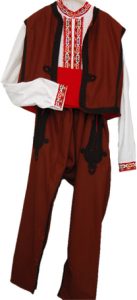 The comparison is not accidental. The rooster is a symbol of male potency and symbolizes the sexually mature man. While children's clothing is made from old and second-hand clothes, grown-up boy's clothing is new, richly decorated. The vest is sleeveless and open over the shirt, which has a beautifully shaped bosom. Contrary to the old man's clothes, which are also closed at the neck.
The comparison is not accidental. The rooster is a symbol of male potency and symbolizes the sexually mature man. While children's clothing is made from old and second-hand clothes, grown-up boy's clothing is new, richly decorated. The vest is sleeveless and open over the shirt, which has a beautifully shaped bosom. Contrary to the old man's clothes, which are also closed at the neck.
see also: Our folk instruments
The apron. The women's apron is the garment of transition. They are an invariable element of the clothing of lazarkas - young maidens ready to enter marriage, as well as in wedding clothing. When she first puts on an apron, the girl indicates that she has reached sexual maturity and can accept proposals. The aprons of the young girls are bright, with many jingling coins.
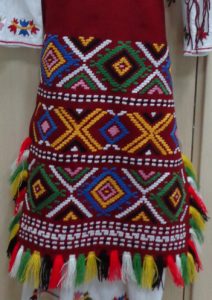 Distinguishing married women from maidens is also done by the type and color of the laces of the apron. Maidens tie their ties on the left, and married women on the right. For old men, the aprons are wider, often of two layers, as for pregnant women. Here the coincidence comes from the belief that both the woman in labor and the old woman are on the border between two worlds. They are framed along the edge with a joining seam and attached ties. They have a specific decoration: colors, ornaments or additionally sewn coins, sequins, beads, strips, etc. The signs on the aprons in the individual settlements are strictly defined and are a mark for recognizing the origin of the woman. In terms of importance, the apron is no less important than the shirt. The symbols embedded in the embroidery of the shirt are embedded even more brightly in the apron. The presence of a rhombus, symbolizing the world tree, is emphasized. It is the figure that evokes sexuality and fertility.
Distinguishing married women from maidens is also done by the type and color of the laces of the apron. Maidens tie their ties on the left, and married women on the right. For old men, the aprons are wider, often of two layers, as for pregnant women. Here the coincidence comes from the belief that both the woman in labor and the old woman are on the border between two worlds. They are framed along the edge with a joining seam and attached ties. They have a specific decoration: colors, ornaments or additionally sewn coins, sequins, beads, strips, etc. The signs on the aprons in the individual settlements are strictly defined and are a mark for recognizing the origin of the woman. In terms of importance, the apron is no less important than the shirt. The symbols embedded in the embroidery of the shirt are embedded even more brightly in the apron. The presence of a rhombus, symbolizing the world tree, is emphasized. It is the figure that evokes sexuality and fertility.
It was believed that the apron supports the woman in transitional moments of life and - wedding, birth, death. Especially during childbirth. Popular practices to relieve the pain of childbirth or to stimulate it, to drive away evil forces and transmit additional power are touching, hitting the waist or interrupting with an apron - that of the midwife or mother-in-law. Another practice is the removal of the apron from the woman in labor during childbirth, as well as the removal of the aprons of all women present, including those who are not in direct contact with the woman in labor and happen to learn of the birth process that has begun. And because the newborn comes from another world, the world of the great-grandfathers, it is necessarily taken in an apron. This is how it is symbolically introduced into the family, the clan, the community. It is also an important element in the reverse process when it is time to leave this world. The last sweeping of the grave is done with the apron of the woman closest to the deceased in the family: mother, wife, sister. The women present again remove their aprons.
To be continued…
© 2023 Iliana Dechkova

